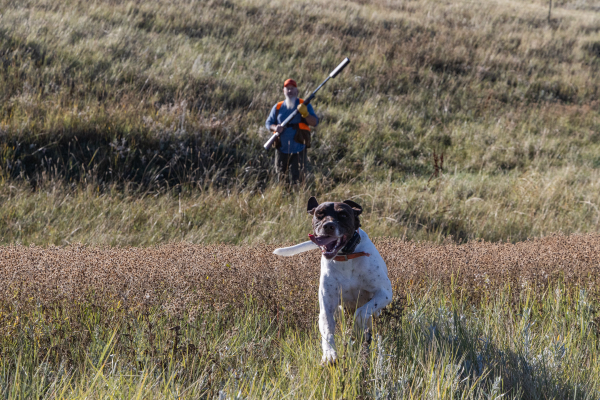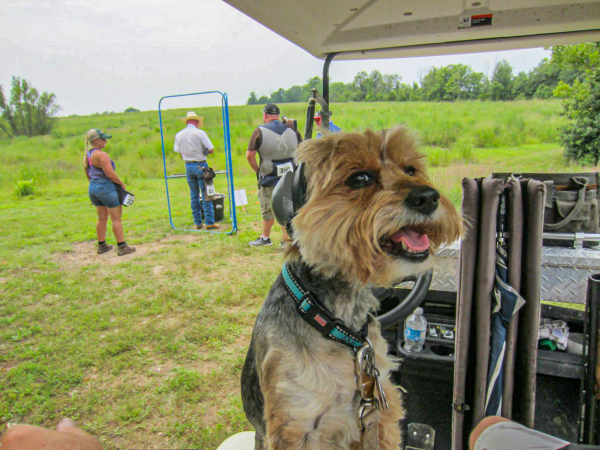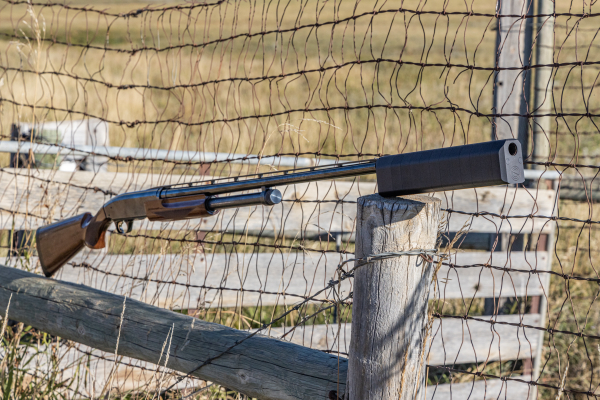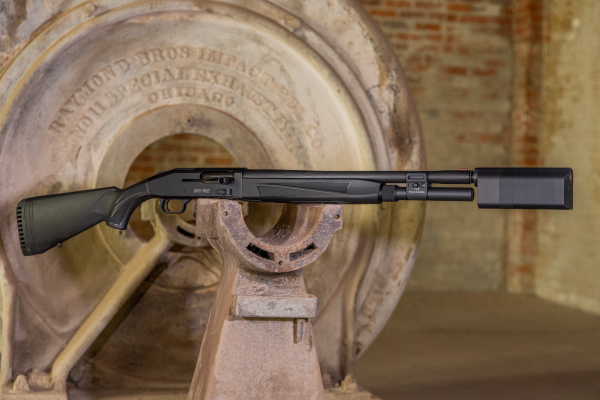
“I want you to explore a different angle on the shotgun suppressor. How useful would it be in dog training?” editor Jay Pinsky posed.
I rolled the thought around in my head, knowing that he had touched on something solid. Very solid.
When I first got serious about bird dogs, a mentor of mine had started dropping tidbits that wormed their way deep into my head – little things that just stuck with me. In exemplum, four years is the ideal spacing between bird dogs, that way you always have a pup in training, a master in its prime and a retiree who gets to live in the lap of luxury the rest of its years. Occasionally you might have two old fogies, but not often.
As I continued to work alongside this sage of shotgunning, I noticed a recurring theme with his elder dogs – they never failed to go deaf as they reached their later years.

“Well yeah, it might be a little bit genetics but I don’t even know how many thousands of rounds Chester got – and from the muzzle end of the gun,” shotgun designer, professional shooter and instructor Dave Miller reflected. “He probably ran 50 or 60 150-200 bird continental shoots, and there were some weeks where we’d do three days with three shoots. At every one of those, the guys were shooting a couple cases of shells and he heard all those shots – I know that’s why he went deaf.”
My own bird dogs had never seen the sheer numbers that Dave’s had, and even they began to get a bit deaf before their time here was over. To see how common it might be, I turned to trainer and field trialer Dan Murray of Absolute Gundogs.
“That’s funny, we were just talking about that the other day. Some dogs go deaf at 12 or 13 while others might be at 9 or so. The ones you hunt more, like my trials dogs, they’re getting trained 6-7 months out of the year and then going to competitions, and their hearing tends to go at 9 or 10 years,” Dan reflected.
“I’d have a hard time even estimating how many shells we shoot a year – it’s pallets. Even with our waterfowl dogs, we’re shooting dummy launchers over them and that has to have an effect too. The genetic component is there also – some dogs go deaf at 8 even. A couple years early to us, but in dog years that’s actually a long time…”
At first blush, the thought of a hearing test for dogs might seem silly or impractical, but they do exist, and the BAER test that became the standard in the 1970s is rather effective. Not only does it provide reliable data regarding the presence of deafness, it also speaks to severity, gives specificity and provides repeatable results while doing so in a non-invasive manner. The test itself measures brain activity when the subject is exposed to auditory stimuli, so if the signals are making out of the ear and to the brain, technicians will know.
Using both BAER examinations as well as a tympanometer to rule out middle ear pressure irregularities, researchers in Ankara, Turkey published a paper regarding the effects of gunshots on pointing dogs. In cooperation with hunters, 40 German Shorthairs were tested after they returned from hunts where shotguns were fired over them and results were recorded, showing not only acoustic trauma resulting in deafness but a correlation between where the dog was in relation to the shotgun’s muzzle and how much trauma they experienced.
The results were interesting in that even though dogs’ ears are said to be four times more sensitive than a human’s, within the frequencies produced by gunshots they are actually rather similar.
Since we share sensitivities in these frequencies, dogs would be expected to have irreparable hearing loss with each and every shot fired over them, since that threshold occurs at 140 dB and a typical 12 gauge blast will clock in between 150 and 160 dB. The resulting recommendation of the study was:
In order to be protected from the detrimental effects of acoustic trauma, hunters should be informed about products developed for dogs, as those products may be beneficial.
After my first experience shooting suppressed, I quickly formed the opinion that while ear plugs and electronic muffs are fine, they just don’t compare to the enjoyment had while using an effective suppressor. From pistols and rimfire to sub guns and hunting rifles, I came to love shooting suppressed. The one thing I hadn’t done was try one on a scattergun, even though I shoot more rounds through a shotgun each year than I do any other firearm.

To see how viable a shotgun suppressor might be, I set up one of my lesser-used pumps (a Browning BPS) with SilencerCo’s Salvo 12 gauge can and headed into the hills with my dad.
Attaching the Salvo was simple – screw out the factory choke and fit the mount of your choice. In my case, that meant one in a Browning Invector Plus pattern choke in Modified constriction. Once the mount was on, the Salvo itself slipped over it and the locking collar on the mount tightened to the suppressor by way of an included spanner. Simple as can be and plenty secure.
The resulting shotgun was visually dramatic. A normal-sized shotgun had now grown to a behemoth, standing nearly six feet in height.
“That’s not going to fit in any gun case you’ve got…” chuckled my father.
“Heck, it might not fit in the truck!” I exaggerated.
Carrying it in the field was somewhat comical, especially in its full-length configuration. At 12” long, the modular suppressor can be configured shorter (all the way down to 6”), but with reduced suppression capabilities. On the flip side, configuring it shorter allows for the use of higher velocity shells, which is a plus when hunting.

After a morning working our pointer in the Wyoming hills we had figured one thing out – while the Salvo’s sound suppression and recoil reduction were surprisingly good, the way we had configured it and with a full-length gun it just wasn’t a viable option. The suppressor itself isn’t terribly heavy, but when hung off the end of an already-long shotgun, the weight is amplified.
But what if it could be put on a smaller gun? Regarding the question at hand, most upland dogs are trained over pigeons or pen-raised quail, just about any load and shotgun can be used to effectively down birds for retrieval. Why not suppress a 20, 28 or .410? I imagine that a .410 suppressor would be downright perfect given the often whippy nature of that smallest sub-gauge. Sticking a suppressor on the end would lend one a much more deliberate swing and the overall gun would more similarly resemble a full-size 12 gauge, making it much easier to carry in the field than the beast my father and I had created.
But the economics of building a low-demand product like that likely precludes it from being made – the vast majority of demand will always be in the most common gauge.
One beauty of the Salvo, though, is in its modularity. Disassembly and reassembly with a simple rod kit allows the suppressor to shrink by half. When equipped on a short-barreled pump or semi-auto (think defensive or turkey-specific shotgun), the length issue disappears entirely. Suppression isn’t quite as good, but the unwieldy behemoth transforms into a perfectly manageable firearm.
As our conversation continued, Dan brought up a point I hadn’t considered.
“For me, 12 gauge is just fine, but it would need to work on an over/under since we rely on break-open guns from a safety aspect. With an over/under it is clearly safe when it’s open – there’s no question. A semi-auto or pump doesn’t give that,” remarked Dan. “To me, that’s an immediate issue and we just won’t use them.”
Given the complexity of a two-barreled suppressor, the real answer for Dan would be a single shot break-open gun, but the issue there would be finding one that takes a choke – not impossible but single-shots have seen a steadily declining market to the point that not many companies currently produce one.

In its full-size configuration, the Salvo’s true calling would be in a goose pit or duck blind – situations where semi-autos are the norm and it doesn’t have to be carried, just picked up and used. I imagine all the rounds I’ve fired in my younger years from inside metal goose pits that left my ears ringing and the thought of sticking my ear pro on the end of the barrel was pretty darn appealing.
Additionally, screwed onto the end of a short defensive shotgun in its 6” form would be near ideal, since lighting off a shotgun in the close quarters of a house would be a great way to blow out what little hearing I have left. Or more realistically, the times where a late-night raid on our chicken coop was going down and the offending predator needed to be dealt with – always an ear-ringer and a much more common occurrence.
With dog training, it very well could work when in its short configuration, but you’ll have to be ok with using a just-legal-length pump or semi-auto as the host and not getting quite the suppression of the full can. Is the time, investment and extra government intrusion worth the hearing protection?
“The question really is does the owner want to get a few extra years out of their dog’s hearing?” Dan posed. “In that case, it might just be worth it…”